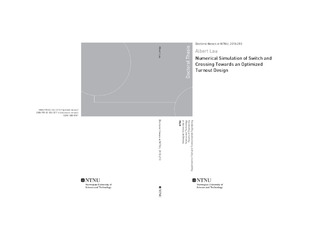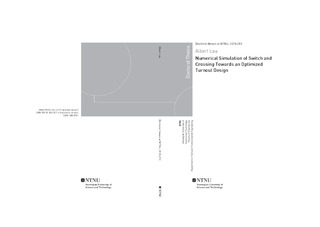| dc.contributor.advisor | Løhren, Alf Helge | |
| dc.contributor.advisor | Wan, Chang | |
| dc.contributor.author | Lau, Albert | |
| dc.date.accessioned | 2018-07-18T08:44:52Z | |
| dc.date.available | 2018-07-18T08:44:52Z | |
| dc.date.issued | 2018 | |
| dc.identifier.issn | 1503-8181 | |
| dc.identifier.uri | http://hdl.handle.net/11250/2505971 | |
| dc.description.abstract | Switch and crossing (S&C) or turnout is a mechanical component within railway infrastructure that provides flexibility for train to switch from one track to another. However, such flexibility requires certain degree of geometry changes and discontinuities and these changes often result in high impact forces. Because of the high impact forces, damage frequency in turnout is often higher compared to normal track. It often requires more attention compared to normal track too. Therefore, turnout is a very costly component within railway infrastructure. As a result, researchers have been striving to understand this component better to make it less costly. However, understanding turnout itself is a very costly task especially if the investigations need to be carried out on track on-site. For example, to mount devices on the track, acquiring data and analyzing results are very labor-intensive. In addition, the track needs to be especially made available and special arrangement is needed for the train driver to drive the train over the track under specified controlled conditions. Because of that, many researchers have turned to numerical modelling which is a cheaper alternative. Multibody simulation (MBS) has been one of the most popular modelling techniques used to model turnout. MBS is well known for its computational efficiency and its capability to model wheel-rail kinematic especially in turnout. However, the tool was originally designed mainly to model train dynamics under train-track interaction. So improvements are still needed when train-track dynamics as a whole is of interested, especially when the role of the track is critical. Therefore, in this study, two improvements have been made in turnout modelling in MBS with an aid of a commercially available MBS software, GENSYS. The first improvement is to include yaw effect of train’s wheelset during the simulation. Conventionally, the wheelset of a train is assumed to be always perpendicular to the track axis during the simulation. However, when a train is travelling through curves, especially small curves, the wheelsets often inherit certain level of angle of attack. This applies in turnout too because of the absence of the cant elevation in turnout. Thus, a methodology has been developed to include the yaw effect of the wheelsets in the simulation. It is concluded that the yaw effect has influence towards contact point calculation and eventually train derailment prediction. The second improvement is development of a better track modelling approach in the MBS environment. Conventionally, the track in MBS is modelled as a lumped mass following the train wheels during the simulation. This type of track model is sufficient for normal railway track modelling. However, for turnouts of which bending stiffness of the rail and geometry of the sleeper changes immensely along the track, lumped mass track assumption is no longer sufficient. Therefore, an approach considering full track model in the simulation that is fixed in the continuum includes rails discretely supported by sleepers sitting on an elastic foundation has been developed. The train travel through the track instead of having the track follows the train during the simulation. With this track, some important parameters such as rail bending stiffness variation and sleeper geometry variation have been made possible to be included in the modelling. Besides, time history of the track such as force exerted on the sleepers, sleeper displacement, and force exerted on the ballast have been made possible to be studied. Based on the development, a right hand 60EI-R760-1:15 turnout without rail inclination has been modelled. The effect of the rail bending stiffness variation and sleeper geometry variation has been discussed. Finally, the turnout model is used for an optimization task. The aim of the optimization task is to find the optimized railpad stiffness for the turnout by using an optimization technique call genetic algorithm. Different cases such as two different train types, different ballast stiffness and travelling directions have been considered. A guideline for the best railpad vertical stiffness of the turnout under a specific setup has been suggested by the optimization. In conclusion, soft railpad stiffness is recommended as long as vertical compressive displacement of the railpad does not exceed 2 mm. Besides, it might be safe to use railpad with vertical stiffness of 33 MN/m throughout the turnout as long as the axle load of the train is not more than 22.5 ton and the train is not travelling faster than 200 km/h. Keywords: Switch and crossing, turnout, wheelset yaw, Full MBS track, railpad optimization. | nb_NO |
| dc.language.iso | eng | nb_NO |
| dc.publisher | NTNU | nb_NO |
| dc.relation.ispartofseries | Doctoral theses at NTNU;2018:210 | |
| dc.relation.haspart | Paper A: Lau, Albert; Kassa G, Elias. Simulation of vehicle-track interaction in small radius curves and switches and crossings. I: Proceedings of the Third International Conference on Railway Technology: Research,
Development and Maintenance
Paper 126, 2016, - Is not included due to copyright available at
http://doi.org/10.4203/ccp.110.126 | nb_NO |
| dc.relation.haspart | Paper B: A. Lau and I. Hoff, ‘Simulation of train-turnout coupled dynamics using a multibody simulation software | nb_NO |
| dc.relation.haspart | Paper C: A. Lau, C. Wan, A. H. Løhren and I. Hoff, ‘A methodology for switch and crossing optimization’,
ICRT 2017- First International Conference on Rail Transportation -
Is not included due to copyright available at
https://doi.org/10.1061/9780784481257.097 | nb_NO |
| dc.relation.haspart | Paper D: A. Lau, C. Wan, A. H. Løhren and I. Hoff, ‘Numerical switch and crossing railpad vertical stiffness optimization | nb_NO |
| dc.title | Numerical Simulation of Switch and Crossing Towards an Optimized Turnout Design | nb_NO |
| dc.type | Doctoral thesis | nb_NO |
| dc.subject.nsi | VDP::Technology: 500::Environmental engineering: 610 | nb_NO |

